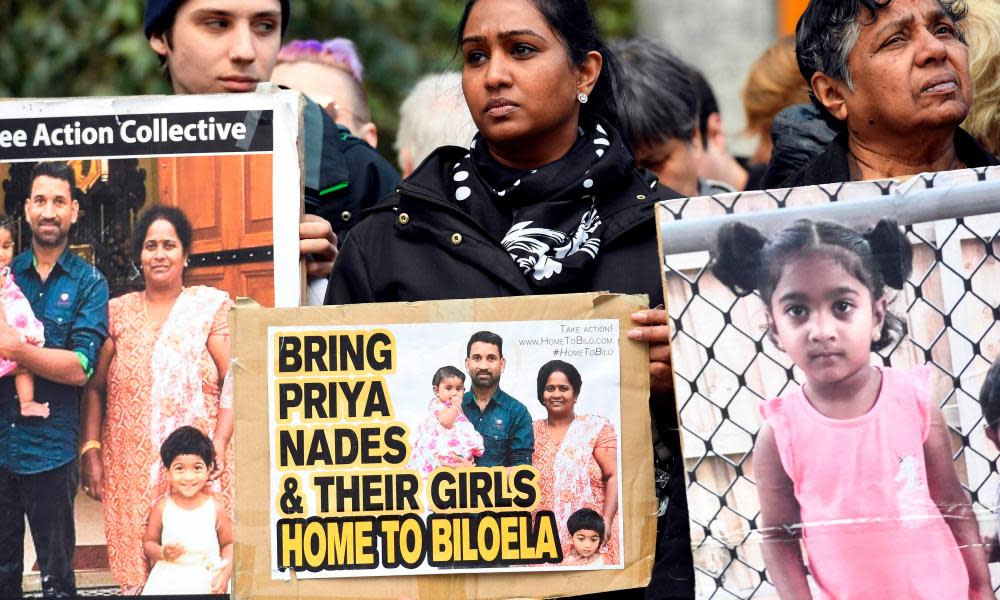Stateless is a TV show – but it's also the harsh reality behind the wire in Australian detention

Cate Blanchett’s new show Stateless offers a compelling insight into a long-running and divisive issue in Australia. Set in 2004, the series follows four characters who find themselves entangled in Australia’s immigration detention system in a remote desert location. It makes for powerful viewing. The reality of Australia’s detention system today, however, is far more harrowing.
Nobody understands this better than Sami. Arriving to seek refuge in Australia over five years ago with his heavily pregnant wife, his first child was born into a life of detention. Clutching his newborn shortly after her arrival, he made a desperate, hurried phone call to a lawyer from his compound on the Australian territory of Christmas Island where they had been detained, 1,500kms from the mainland. By the time help arrived it was too late – they’d been frog-marched on to a pre-dawn charter flight to an Australian operated detention centre almost 7,000kms away, on the tiny island nation of Nauru.
Related: Stateless review – thrilling, surprising drama interrogates painful Australian truths
They were later ping-ponged back to a remote detention centre in the Australian desert, not dissimilar to that depicted in Stateless. His wife’s second pregnancy was deemed too high-risk to occur offshore. Two guards stood on either side of her hospital bed as she held their newborn son, watching as she attempted to breastfeed him for the first time. Her hands shook from fear and shame. The family’s legal team have since done what they can to hold them in Australia, but the risk of return to Nauru remains ever-present. Every day they wake, unsure if today will be the day.
This is a family that spent almost two years in closed immigration detention in Australia – in an isolated camp far from the public eye. Both children were born into detention – the eldest spent the first 18 months of her life behind wire. The father tells me he worries about the lasting damage this has done to them. His eldest has developed learning difficulties – the other regularly wakes in terror.
In an indication of how fraught Australia’s immigration policy is for people seeking asylum, this family is actually one of the luckier ones. They are now living in the community, albeit in a form of home detention akin to parole – at risk of return to closed detention at any time. According to the government’s most recent statistics, 1,450 men and women are locked up in immigration detention centres on the Australian mainland today – more if we include those who remain in limbo after almost seven years in Nauru and PNG. Two small children are behind bars on Christmas Island – children that belong back in their community of Biloela.
The average length of time for people held in Australian detention is currently more than 500 days; shockingly, some have been held for more than eight years. This is far longer than any other comparable jurisdiction. Take, for example, Canada, where the average length of detention is no more than one month.
And conditions inside these centres are getting dangerously worse. A recent report by the Australian Human Rights Commission found that our detention system is becoming “more and more like prison”, unlike any other liberal democracy in the world.
Stateless is set in 2004. So how is it that 16 years later the situation is so much worse? Toxic politics aside, how is it that this system of indefinite detention is legal? Numerous international bodies have found that it constitutes “arbitrary detention” and in some cases amounts to “cruel, inhuman or degrading treatment”. But because we have no national Charter of Rights, these fundamental principles are not binding in Australian law.
Related: Australian mother of five stripped of citizenship, leaving two children potentially stateless
Indefinite detention is a particular risk for stateless people – those not considered to belong to any nation – for the simple reason that they have nowhere to go. The Rohingya of Myanmar, Palestinians, and the Roma of Europe are but some of the estimated 10 to 15 million so-called “invisible people” worldwide who bear this status and the discrimination it entails.
This is a reality all too familiar for Sami. “I don’t know how to explain it,” he says. “I don’t have a country. The Australian government says I am a refugee, yet I can’t stay here and raise my family in safety. We have nowhere to go.”
There’s no denying the issue of mandatory detention in Australia is hotly contested and painfully fraught. But within this toxic debate some things remain simple. There is no excuse for damaging people in our care and stealing 500 days – sometimes drastically more – of their lives. This is happening – in our country and in our name – today, right now. Next time you sit down to watch Stateless, spare a thought for the many men and women – and those small children – who remain behind the wire.
• Professor Michelle Foster is the director of the Peter McMullin Centre on Statelessness and a leading expert on refugee and statelessness law
• Katie Robertson is a human rights lawyer and research fellow at the Peter McMullin Centre on Statelessness
• Names have been changed to protect the identities of people mentioned.

 Yahoo News
Yahoo News 
